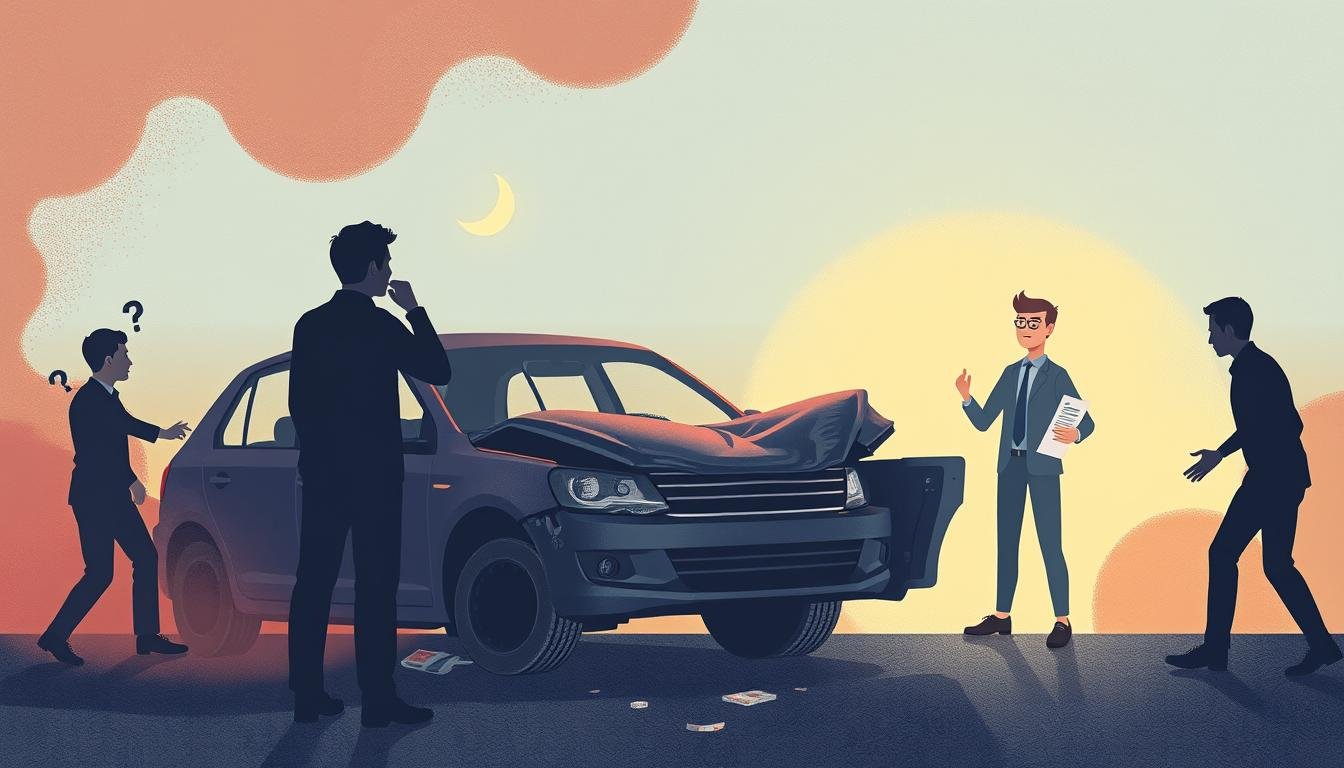Ever thought about what happens when gap insurance doesn’t cover a claim? This insurance is meant to fill the gap between your car’s value and your loan.
But, there are times when it might not offer the protection you thought it would. We’ll explore the limits and exclusions of gap insurance. This will help you understand when it might not pay out and how to make sure you’re covered.
Key Takeaways
- Gap insurance has specific coverage limitations that you should be aware of.
- Understanding the fine print of your gap insurance policy is crucial to avoid surprises in the event of a claim.
- Certain circumstances, such as vehicle modifications or driving while intoxicated, may result in a denied gap insurance claim.
- Familiarizing yourself with gap insurance exclusions can help you make informed decisions about your coverage.
- Reviewing your gap insurance policy regularly can ensure you have the protection you need in the event of a total loss.
What is Gap Insurance?
Gap insurance is a special type of coverage. It offers financial protection to car owners. It helps cover the gap between what you owe on a car and its actual value if it’s lost or stolen.
Also Read: Does Health Insurance Cover Auto Accidents? Find Out!
Gap Insurance Explained
If your car is in an accident or stolen, your insurance might not cover all costs. This is because insurance payouts are based on the car’s current value. Gap insurance fills this gap, so you’re not stuck with the remaining loan or lease payments.
The Purpose of Gap Coverage
Gap insurance is mainly to prevent you from being underinsured. Cars can lose value fast, and what you owe might be more than the car’s worth. Gap insurance ensures you’re not left with the difference if your car is lost or stolen.
“Gap insurance can provide much-needed financial relief in the event of a total loss or theft, allowing vehicle owners to move forward without being burdened by outstanding loan or lease obligations.”
When Does Gap Insurance Not Pay?
Gap insurance offers protection when your vehicle is lost completely. But, it’s important to know when it won’t cover you. Knowing these gaps can help you make better choices and avoid surprises.
Gap insurance has its limits. It doesn’t cover all vehicle losses. Here are some times when gap insurance may not pay out:
- If the vehicle is stolen and not recovered
- If the vehicle is damaged beyond repair due to a natural disaster, such as a flood or tornado
- If the vehicle is deemed a total loss due to excessive mileage or wear and tear
- If the vehicle is used for commercial purposes, such as ride-sharing or delivery services
- If the vehicle is modified or customized beyond the manufacturer’s specifications
Also, gap insurance limitations might include age, mileage, and loan-to-value ratio restrictions. Always check your policy to see what’s excluded.
| Scenario | Gap Insurance Coverage |
|---|---|
| Theft (Vehicle not recovered) | No coverage |
| Natural Disaster Damage | No coverage |
| Excessive Mileage or Wear and Tear | No coverage |
| Commercial Use | No coverage |
| Customized Modifications | No coverage |
Knowing what gap insurance doesn’t cover is key. It helps you choose the right coverage and avoid financial shocks. Being informed lets you decide if gap insurance fits your needs.
Gap Insurance Claims Denied
Gap insurance offers valuable protection for totaled vehicles. Yet, claims can sometimes be denied by the insurance provider. It’s key to understand your policy and the claims process to ensure coverage when needed.
Common Reasons for Denial
Several factors can lead to a gap insurance claim being denied. Knowing the common reasons can help you prepare and increase your claim’s success. Here are some top reasons for denials:
- Policy exclusions: Gap insurance policies exclude certain vehicle types or use cases. Make sure your policy covers your situation.
- Missing information: Incomplete or inaccurate claim documentation can lead to denial. Review policy requirements and provide all needed information.
- Exceeding coverage limits: Gap insurance pays up to the difference between the vehicle’s value and loan balance. Claims over this limit may be denied.
- Deductible issues: If the vehicle’s deductible is higher than the gap coverage, the claim may be denied.
- Delayed reporting: Gap insurance requires prompt reporting of a total loss. Filing the claim late can result in denial.
Understanding these reasons can help you navigate the process better. It increases your chances of a successful claim.
| Reason for Denial | Explanation |
|---|---|
| Policy Exclusions | Gap insurance policies exclude certain vehicle types or use cases. Ensuring your policy covers your situation is crucial. |
| Missing Information | Incomplete or inaccurate claim documentation can result in a denial. Carefully reviewing the policy requirements and providing all necessary information is essential. |
| Exceeding Coverage Limits | Gap insurance has limits on the amount it will pay, typically the difference between the vehicle’s value and the loan balance. Claims that exceed these limits may be denied. |
| Deductible Issues | If the vehicle’s deductible is higher than the gap coverage, the claim may be denied. |
| Delayed Reporting | Gap insurance policies often require prompt reporting of a total loss. Delays in filing the claim can lead to a denial. |
Familiarizing yourself with these common reasons for gap insurance claim denials can help you navigate the process more effectively. It increases your chances of a successful outcome.
Gap Insurance Exclusions
Gap insurance has exclusions and limitations that affect coverage. It’s crucial to understand these to ensure you’re protected.
Policy Limitations to Consider
One common limit is mileage. Most policies cap the vehicle’s mileage at about 100,000 miles. If your car has more miles, the gap insurance might not cover you.
Another limit is the vehicle’s age. Gap insurance usually covers newer cars, up to 5-7 years old. Older cars might not qualify or have limited coverage.
- Mileage restrictions (usually around 100,000 miles)
- Vehicle age limitations (often 5-7 years old or newer)
- Exclusions for certain types of vehicles, such as high-end luxury cars or commercial vehicles
- Restrictions on the amount of coverage, such as a maximum payout or a percentage of the vehicle’s value
Before buying gap insurance, check the gap insurance exclusions and policy limitations carefully. Knowing these limits helps you make a smart choice and avoid surprises later.
Also Read: Target Premium Life Insurance: How It Works for You.
Gap Insurance Fine Print
Gap insurance’s fine print is just as important as the coverage itself. It outlines the policy’s limitations and exclusions. By reading the fine print, you can make a better choice for your needs.
The gap insurance fine print often lists situations where coverage doesn’t apply. For example, it might not cover vehicles used for business or those with custom parts. It also might only last for a few years or a certain number of miles.
The gap insurance disclosures are also key. They talk about the policy’s cost, any deductibles, and how to file a claim. Knowing this ahead of time helps you understand the financial side and if the policy fits your budget.
Reading the gap insurance policy terms carefully can reveal more about what’s not covered. Some policies might not cover theft, natural disasters, or certain driving habits. It’s important to know these details.
“Knowing the fine print of your gap insurance policy can mean the difference between a smooth claim process and a costly surprise down the road.”
Understanding your gap insurance policy’s fine print helps you make smart choices. It ensures you get the right coverage for your vehicle.
Understanding Gap Insurance Coverage
Gap insurance has its limits, but it’s key to know when it helps. This part will explore when gap insurance protects you. This includes when your car is totaled or stolen, and how much help you can expect.
Covered Situations with Gap Insurance
Gap insurance kicks in when your car is a total loss, from an accident or theft. It fills the gap between what you owe on your car loan and what your car is worth. This way, you won’t be stuck with the leftover debt.
- Vehicle Total Loss: If your car is totaled, gap insurance helps pay off the loan balance. It covers the difference between what you owe and your car’s value.
- Vehicle Theft: If your car is stolen and not found, gap insurance helps too. It covers the gap between the loan balance and your car’s value, protecting your finances.
The amount of protection gap insurance offers can vary. It’s vital to check your policy details. This way, you’ll know exactly what it covers and how much protection it provides.
| Covered Scenarios | Gap Insurance Coverage |
|---|---|
| Vehicle Total Loss | Covers the difference between the outstanding loan balance and the car’s actual cash value |
| Vehicle Theft | Covers the difference between the loan balance and the car’s actual cash value |
Knowing about gap insurance coverage and covered situations with gap insurance helps you decide. It’s about whether this extra protection fits your needs and financial situation.
Reading the Policy Terms
Gap insurance can seem complex, but it’s key to know what you’re getting. By reading the fine print, you can spot any gaps or exclusions. This helps you make smart choices about your coverage.
When you look at your gap insurance policy, focus on a few important things:
- Coverage Limits: Know the max your gap insurance will pay if your car is lost or stolen. This info is usually in the “Limits of Liability” section.
- Exclusions: Check the “Exclusions” section for any times your insurance won’t cover you. This might include car age, mileage, or past damage.
- Deductibles: Find out if you have to pay a deductible before your insurance kicks in. This can change based on your policy.
- Eligibility Requirements: Make sure your car and loan/lease fit the policy’s needs. This could be about car type, loan/lease length, and more.
By reading the gap insurance policy terms and understanding the policy coverage, you can feel secure. Your gap insurance will protect you if your car is lost or stolen unexpectedly.
Gap Insurance Exceptions
Gap insurance offers valuable coverage in many cases. Yet, it has its limits and exceptions. Knowing what’s not covered can help you choose the right insurance. This way, you avoid unexpected gaps in your protection.
Circumstances Not Covered by Gap Insurance
Gap insurance helps with the difference between what you owe and the vehicle’s value. However, it doesn’t cover everything. Key exceptions include:
- Damage or theft not covered by your main auto insurance
- Vehicles with salvage or rebuilt titles
- Commercial or business use vehicles
- Loans over 60 months
- Leased vehicles without gap coverage in the lease
- Down payments less than 20% of the purchase price
Review your gap insurance policy carefully. Know its limits and when it won’t cover you. This helps avoid surprises if you need to make a claim.
| Scenario | Gap Insurance Coverage |
|---|---|
| Vehicle is totaled in an accident | Covered – Gap insurance pays the difference between the vehicle’s actual cash value and the outstanding loan balance. |
| Vehicle is stolen and not recovered | Covered – Gap insurance pays the difference between the vehicle’s actual cash value and the outstanding loan balance. |
| Vehicle is damaged in a flood or natural disaster | Not covered – Gap insurance only covers the difference between the vehicle’s actual cash value and the outstanding loan balance, not the cost of repairs. |
| Vehicle is used for commercial purposes | Not covered – Gap insurance typically excludes vehicles used for commercial or business purposes. |
“Understanding the limitations of gap insurance is crucial to ensuring you have the right coverage for your needs. By knowing the exceptions, you can make informed decisions and avoid any gaps in your protection.”
When Does Gap Insurance Not Pay? Know the Limits
Gap insurance offers protection if your vehicle is totaled. But, it’s important to know its limits and what it doesn’t cover. Understanding these can help you choose the right policy for you.
Gap insurance mainly covers the difference between your vehicle’s value and what you owe. It doesn’t pay for your insurance deductible, past-due payments, or extra fees. It also might not help if your car is stolen and found or if it’s damaged but not a total loss.
Also, gap insurance has rules about your vehicle’s age, mileage, loan type, and down payment. If your vehicle doesn’t meet these, you might not get a claim. This could leave you paying the difference yourself.
FAQ
What is Gap Insurance?
Gap insurance helps cover the gap between what you owe on a vehicle and its actual value if it’s lost or stolen. It’s a financial safety net for those who might not have enough insurance.
What is the purpose of Gap Coverage?
Gap insurance protects you from owing money on a vehicle loan or lease if it’s totaled or stolen. It prevents unexpected costs in these situations.
When does Gap Insurance not pay?
Gap insurance might not cover certain situations. This includes specific vehicle uses, mileage limits, and policy restrictions based on vehicle age or value. Always check your policy’s fine print for these details.
What are the common reasons for Gap Insurance claim denial?
Claims can be denied for several reasons. These include policy exclusions, missing documents, and technical issues. Knowing these can help you avoid problems when filing a claim.
What are the policy limitations to consider with Gap Insurance?
Gap insurance policies have exclusions and limits. These can include mileage restrictions, age requirements, and value-based coverage limits. It’s crucial to review these carefully to ensure you’re covered.
What is included in the Gap Insurance fine print?
The fine print of a gap insurance policy outlines what’s covered and what’s not. It’s essential to read this carefully to understand your coverage fully.
What situations are covered by Gap Insurance?
Gap insurance covers total losses or thefts of your vehicle. It helps pay the difference between what you owe and the vehicle’s actual value at the time of loss.
How can I thoroughly review my Gap Insurance policy terms?
To fully understand your gap insurance, read and review your policy terms. Look for exclusions, limitations, and disclosures. This helps you know where your coverage might fall short.
What are the exceptions and circumstances not covered by Gap Insurance?
Gap insurance policies have exceptions and limitations. These can include exclusions for certain uses, mileage restrictions, or value-based coverage limits. Knowing these can help you understand your coverage’s scope.
Sajjad Hossain is an experienced writer on StatusCaption.xyz, specializing in insurance, business ideas, money management, and investment. With a passion for simplifying complex financial topics, [Author Name] provides clear and actionable insights to help readers make informed decisions in their financial journey. Committed to delivering expert advice and practical tips, Sajjad Hossain aims to empower readers to achieve their financial goals confidently and strategically.



